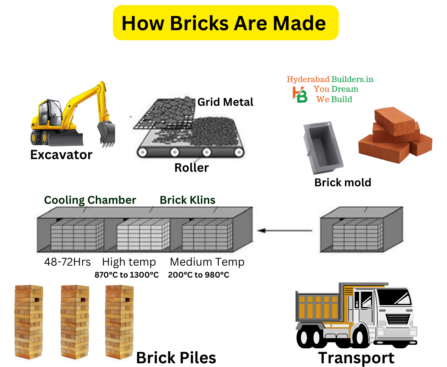How Bricks are made The brick manufacturing industry, though rooted in timeless principles, has undergone transformative changes propelled by technological advancements. While the fundamentals remain unaltered, contemporary brick plants demonstrate increased efficiency and enhanced product quality. Lets dive in to the process how bricks are made and what raw material requires and and what is the step by step brick manufacturing process. the are different type of bricks each has its own manufacturing process the type of manufacturing we choose to manufacture will have effect on both price of bricks and on environment also. Today the brick price in Hyderabad,India is Rs 9.50 Inr/ piece for 1000 bricks price is around Rs 9,500 INR this is standard quality brick price As per Invest India and IBEF, the construction Industry in India is expected to become the 3rd largest construction market globally and to reach USD 1.4 trillion by 2025. Moreover, Real Estate Industry in India is expected to reach USD 1 trillion by 2030 and will contribute to around of% to India’s GDP Raw Materials required in Brick Manufacturing Clay as the Foundation: At the heart of brick manufacturing lies clay, an abundant and naturally occurring mineral on Earth. However, not all clays are interchangeable; they must meet specific criteria to be suitable for brick production. Key attributes include plasticity, the capacity to be shaped or molded when mixed with water, ample strength to retain form, and the ability to fuse at elevated temperatures. Categorizing Clay Varieties: Clays come in various forms, with three primary categories: surface clays, shales, and fire clays. Surface clays, found near the Earth’s exterior, may be upthrusts of older deposits or more recent sedimentary formations. Shales, subjected to high pressures, nearly harden into slate. Fire clays, mined at deeper levels, boast refractory qualities. Shale: Another essential raw material, shale contributes distinct properties to bricks. It is often blended with clay to achieve specific characteristics. Fire Clays: Fire clays are used in brick manufacturing for their ability to withstand high temperatures during firing. They are one of the categorized types of clays. Water: Water is crucial in the manufacturing process, especially during the preparation phase. It is added to clay to achieve plasticity and facilitate the forming process. Engobes (Clay Slurries): Finely ground clay or colorants in the form of engobes are applied to the brick surface during manufacturing to create textures, coatings, and distinctive patterns. Colorants: Various colorants, including iron for red hues, are naturally present in clays. The firing process and kiln control also influence the final color of the bricks. Concrete (for Concrete Bricks): In the case of concrete bricks, cement, aggregates, and other additives are used along with water to form the brick. Sand (for Sand-Lime Bricks): Sand is a key component in the production of sand-lime bricks, contributing to their composition and characteristics. Fly Ash (for Fly Ash Bricks): Fly ash, a waste product from coal combustion, is used in the manufacturing of fly ash bricks. Lubricants: Lubricants derived from processing organic materials are used in the forming process to prevent clay from sticking to molds. Sawdust (as Burnout Material): Sawdust is sometimes used as a burnout material in the firing process, contributing to the environmental efficiency of brick manufacturing How bricks are made? Clay Collection: Suitable clay is gathered from natural deposits or mines. It should have the right composition and texture. Weathering: The clay is left to weather, exposed to the elements, which helps improve its plasticity and workability. Preparation: The clay is mixed with water to form a workable consistency, sometimes adding sand or other materials for better strength. Molding: The clay is shaped into brick forms using molds. It can be done by hand or using machinery. Drying: The molded bricks are allowed to air-dry, reducing moisture content. Firing: Bricks are fired in kilns at high temperatures, ranging from 1,000 to 2,000 degrees Celsius, turning them into durable, solid units. Cooling: After firing, bricks are left to cool gradually, ensuring strength and durability. The final product, shaped and solidified, emerges as durable and versatile building blocks. In the late 19th century, contemporary U.S. brick production predominantly relies on mechanization. Step by step bricks manufacturing process Mining and Storage: Unearthing the Foundation The journey of brick creation commences with the extraction of surface clays, shales, and specialized fire clays from open pits, utilizing robust power equipment. These raw materials, brimming with potential, are then meticulously transported to designated storage areas within the manufacturing plant. The strategic storage not only ensures a continuous production flow, regardless of weather conditions but also facilitates blending, a crucial step for achieving uniformity, controlling color variations, and meeting specific brick body requirements. Preparation: Shaping the Raw Potential Before the alchemy of brick formation begins, large clay lumps and stones undergo a transformative size reduction. This critical preparation step involves the precise processing of materials through inclined vibrating screens, an intricate dance that regulates particle size. This meticulous preparation sets the stage for the subsequent phases of the manufacturing process. Forming the Brick: Crafting Excellence The heart of the manufacturing process beats within the forming phase, where clay transforms into the iconic brick shapes. Three primary processes govern this phase: Stiff-Mud Extravaganza: Approximately 90% of U.S. brick production unfolds through the stiff-mud process. Clay is extruded, de-aired in a vacuum chamber, and meticulously cut to precision. This intricate dance enhances workability, plasticity, and strength. Soft-Mud Elegance: Embracing clays with higher water content, the soft-mud process involves molding the clay in lubricated molds. The result? Exquisite brick forms, each a testament to the adaptability of the manufacturing process. Dry-Press Precision: Suited for low-plasticity clays, the dry-press process employs minimal water. Hydraulic or compressed air rams then press the clay into steel molds, showcasing precision and efficiency. Drying: From Wet to Solid Wet bricks, embodying 7 to 30 percent moisture contingent on the forming method, undergo a delicate drying phase. Within dedicated chambers, temperatures ranging from 100 ºF to 400 ºF guide the bricks through

